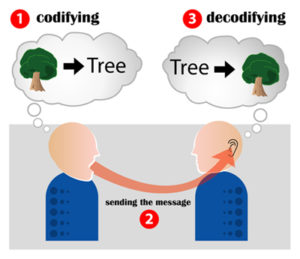
According to a popular model of communication, information transfer is accomplished by means of a message that reflects ideation on the part of a speaker/writer and interpretation on the part of at least one hearer/reader.
I reject the common model of communication and instead conceive human behaviour more in the way understood by the linguists Kenneth and Evelyn Pike. In interaction with phenomenological ideas articulated by Edmund Husserl and developed by Paul Ricoeur, I understand fundamental entities in human groups to be about community (the people and relevant objects perceived to be included), communication (any behaviour that is socially relevant, including talking and writing), and communion (aka belonging, or us, the experience of members of the community as they are together). These relevant aspects of any group emerge from key processes: hospitality (where the community provides a place and support for newcomers and members), charity (where the actions of all participants are taken in the best possible communicative light), and compassion (where the experience of an “other” is taken to be one’s own).
The model that results from these basic events and participants is quite messy and better explains the frequency of miscommunication and negotiation of understanding that are common in everyday social life.
Now, as I reflect upon the video I included in the first post for this course and upon the readings for this lesson (otl201, lesson 1), I am encouraged that I achieved a balance of professional informality that I believe students would find helpful. In order to increase my social presence in this video, I would aim for similar informality, but I would include overt references to the course being taught (in this case, I am preparing to help students in CMNS 3211, so I would overtly refer to the course in the video). I would also select an object that is directly relevant to the course. Finally, my closing would directly invite students to respond and create a video discussion around an item of interest in the course. In CMNS 3211, the central item being considered is social media and the formation of digital communities, so the consideration of how we create community together in the online course is both practically and theoretically relevant. Our interactions have relevance as we develop community, but also as practical demonstrations of the success of our efforts and their measurability.